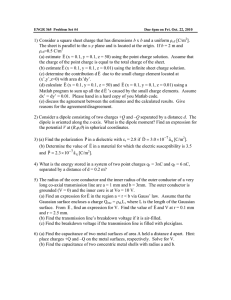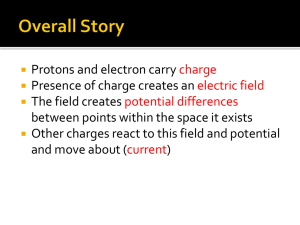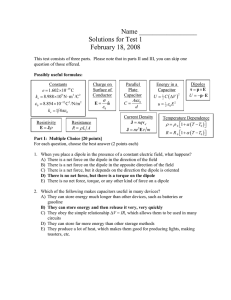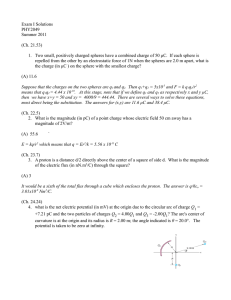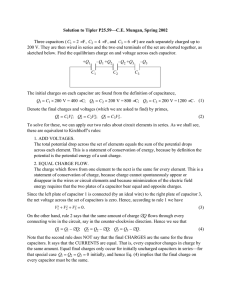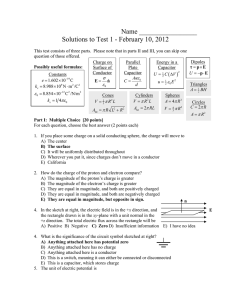Name _________________ Test 1 February 18, 2008
advertisement
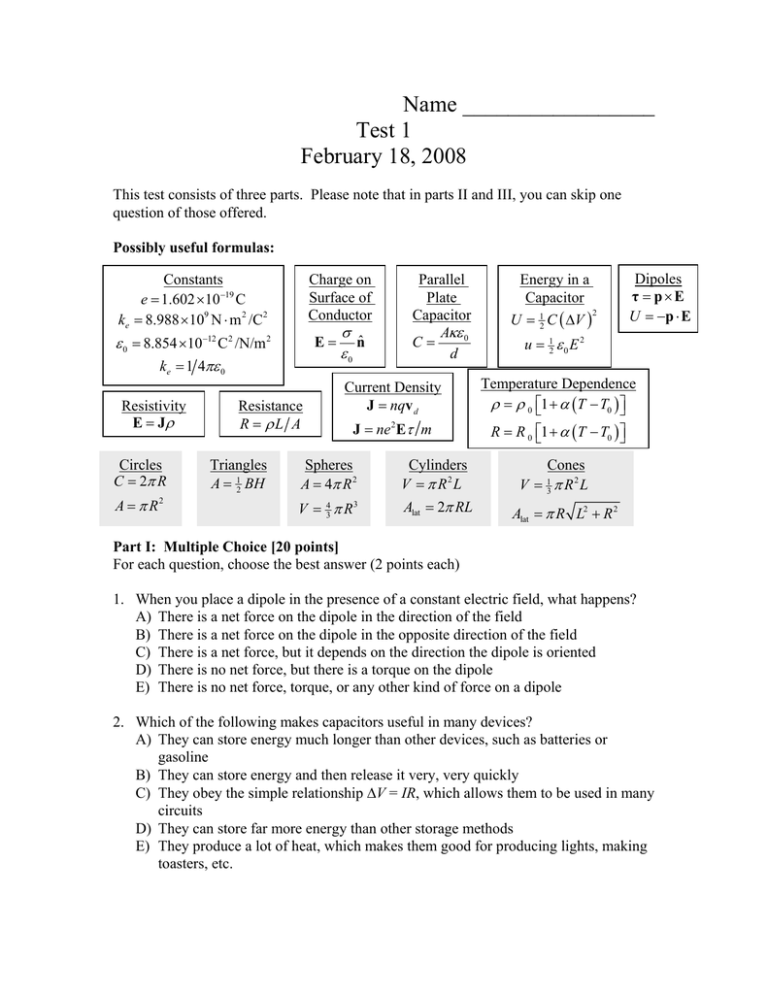
Name _________________ Test 1 February 18, 2008 This test consists of three parts. Please note that in parts II and III, you can skip one question of those offered. Possibly useful formulas: Charge on Surface of Conductor Constants e = 1.602 ×10−19 C ke = 8.988 × 109 N ⋅ m 2 /C2 E= ε 0 = 8.854 ×10−12 C2 /N/m 2 ke = 1 4πε 0 Resistivity E = Jρ Circles C = 2π R A = π R2 Resistance R = ρL A Triangles A = 12 BH σ nˆ ε0 Parallel Plate Capacitor Aκε 0 C= d Energy in a Capacitor 2 U = 12 C ( ΔV ) Dipoles τ = p×E U = −p ⋅ E u = 12 ε 0 E 2 Current Density J = nqv d Temperature Dependence ρ = ρ 0 ⎡⎣1 + α (T − T0 ) ⎤⎦ J = ne2 Eτ m R = R 0 ⎡⎣1 + α (T − T0 ) ⎤⎦ Spheres A = 4π R 2 V = 43 π R 3 Cylinders V = π R2 L Alat = 2π RL Cones V = π R2 L 1 3 Alat = π R L2 + R 2 Part I: Multiple Choice [20 points] For each question, choose the best answer (2 points each) 1. When you place a dipole in the presence of a constant electric field, what happens? A) There is a net force on the dipole in the direction of the field B) There is a net force on the dipole in the opposite direction of the field C) There is a net force, but it depends on the direction the dipole is oriented D) There is no net force, but there is a torque on the dipole E) There is no net force, torque, or any other kind of force on a dipole 2. Which of the following makes capacitors useful in many devices? A) They can store energy much longer than other devices, such as batteries or gasoline B) They can store energy and then release it very, very quickly C) They obey the simple relationship ΔV = IR, which allows them to be used in many circuits D) They can store far more energy than other storage methods E) They produce a lot of heat, which makes them good for producing lights, making toasters, etc. 3. When you use the formula for the difference in electrical potential between two points, ΔV = − ∫ E ⋅ ds , what path are you supposed to take between the two points you are measuring the potential difference? A) You must take a straight line B) You must take a path that always runs parallel to the electric field C) You must take a path that always runs perpendicular to the electric field D) You must take a smooth circular path between the two points E) It doesn’t matter what path you take; you get the same potential no matter what 4. How does the electrical resistance of a superconductor compare with a really good conventional conductor like silver? A) It has no measurable resistance B) It has significant resistance, but much less than silver C) It has resistance comparable to silver D) It has more resistance than silver, but not a lot more E) It has much more resistance than silver 5. If you place charge on a solid conducting sphere, the charge will A) All move to the surface of the sphere B) Be spread throughout the sphere uniformly C) Be concentrated at the center of the sphere D) Go to either the center of the surface, depending on what other charges are nearby E) Conductors cannot have net charge on them because their potential is always zero 6. Sketched at right is a Gaussian surface, with various charges arranged as shown. Assume that any charge that appears to be inside the surface really is inside it. What is the total electric flux out of the surface? +8 μC A) + 2 μC/ε0 +2 μC B) - 2 μC/ε0 C) + 4 μC/ε0 +9 μC -6 μC D) - 4 μC/ε0 E) +6 μC/ε0 -7 μC 7. How does the electric force between two protons 1 nm apart differ from the force between two electrons 1 nm apart? A) The electron force is smaller B) The electron force is bigger C) The electron force is the same size, but it is attractive, whereas the protons are repulsive D) The electron force is the same size, but it is repulsive, whereas the protons are attractive E) The forces are the exact same size, and both proton-proton and electron-electron forces are repulsive 8. Which of the following most accurately describes what happens to charges in an insulator when electric forces are applied to it? A) Charges are free to flow in it, so they shift large distances in reaction to the electric field B) A small fraction of the charge is free to flow, so this small fraction moves a long distance C) The charges cannot flow long distances, but they can move slightly, so they shift their positions D) Insulators don’t have charges that move, so there is no reaction at all E) I have no idea; please mark this one wrong 9. Assume in the figure at right, the number of charges + – – drawn represents the relevant charge density of the + two types of charge carriers, whose charges are equal – + – + and opposite, and the arrows represent the drift + + – velocities. What direction is the current density? – A) Right B) Left C) There is no current density D) It is impossible to tell without knowing the drift velocity of each charge carrier E) It is impossible to tell, even if you know the drift velocity of each charge carrier 10. The circuit symbol shown here is the symbol for a A) Capacitor B) Battery C) Ground D) Resistor E) Switch Part II: Short answer [20 points] Choose two of the following questions and give a short answer (1-3 sentences) or brief sketch (10 points each). 11. Explain qualitatively how a lightning rod works. 12. What factors are important when selecting a dielectric material to put in a capacitor? 13. Copy the three charges sketched below onto your answer sheet. Then make a qualitative sketch of the electric field -3 +8 lines. The numbers represent the relative size of the different charges -3 Part III: Calculation: [60 points] Choose three of the following four questions and perform the indicated calculations (20 points each) 14. A 12.0 V battery is connected to three 12 V capacitors as shown at right. C1 = 30.0 μF and C2 = 10.0 μF. The third capacitor, C3, is a C3 parallel plate capacitor with area A = 0.900 C C 1 2 m2, separation d = 1.00 μm, and initially 30.0 μF 10.0 μF nothing between the plates (a) What is the capacitance of the capacitor C3? (b) What is the capacitance of the whole combination of the three capacitors? (c) What is the total energy stored in the capacitors by the battery? (d) What would be the capacitance C3 if you filled up the space with a dielectric fluid with dielectric constant κ = 2.73? 15. A wire is in the form of a long Resistivities and temperature coefficients at 20° C cylinder of radius r = 1.00 mm. In Temperature total the cylinder is 20.0 m long, Material Resistivity (Ωm) Coefficient (°C-1) with the first 15.0 m consisting of Iron 10 × 10-8 5.0 × 10-3 iron and the last 5.0 m consisting Lead 22 × 10-8 3.9 × 10-3 of lead. (a) What is the total resistance of the wire at 20.0° C? (b) If the wire is connected to a 120 V power source, calculate the current I and the power P consumed in the wire. (c) Due to the heat in the wire, its temperature rises to 120.0° C. What is its total resistance now? 16. A point positive charge q is placed at the center of a hollow spherical conductor of inner radius a and outer radius b. The conductor itself has an additional negative charge – 2q placed on it. Find the magnitude and direction of the electric field at all points; that is, find (a) E for r < a (b) E for a < r < b (c) E for r > b (d) Find the total charge on the inner surface of the conductor. -2q q b a 17. As calculated in class, the electric potential a distance z above the center of a disk of radius a and charge density σ is given by: V ( z ) = 2π keσ ( z 2 + a2 − z ) P z a (a) What is the direction of the electric field at the point P? Calculate a formula for Ez, the electric field in the z-direction at P. (b) A small object with charge q = 2.70 μC and mass m = 5.10 g is placed at rest at the point P. The disk has surface charge density σ = 470 μC/m2, radius a = 1.1 m, and the small charge starts a distance z = 0.61 m away. The small object is allowed to accelerate to infinity without encountering any friction. Find its speed at infinity.
